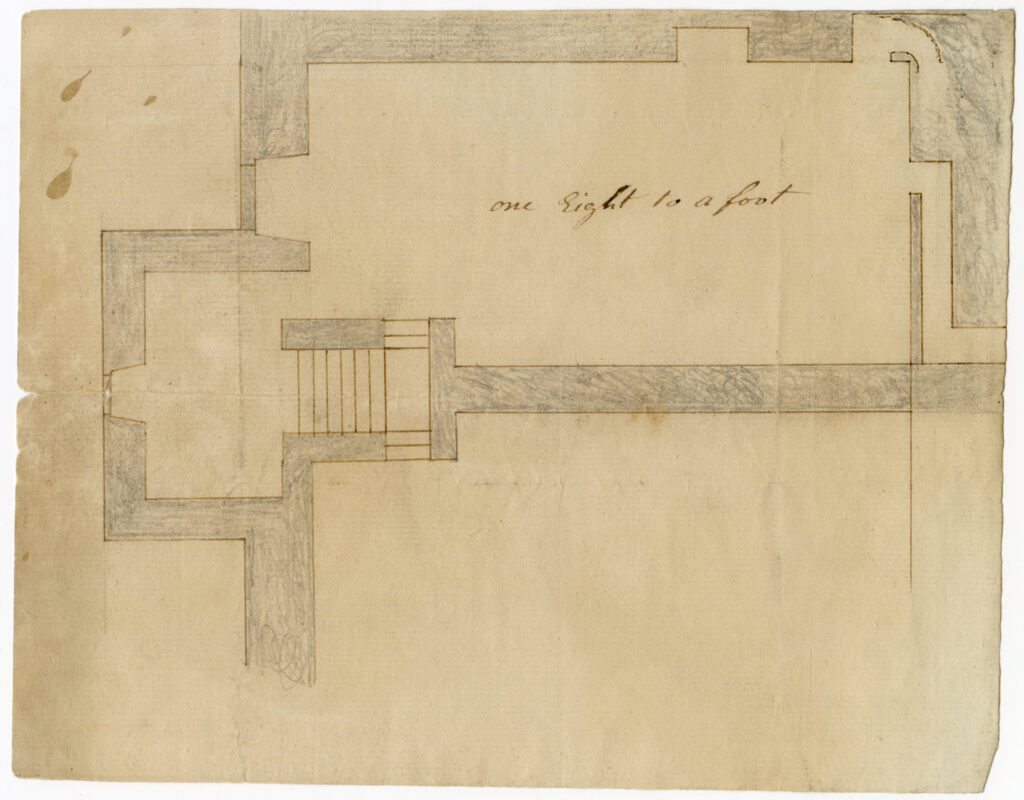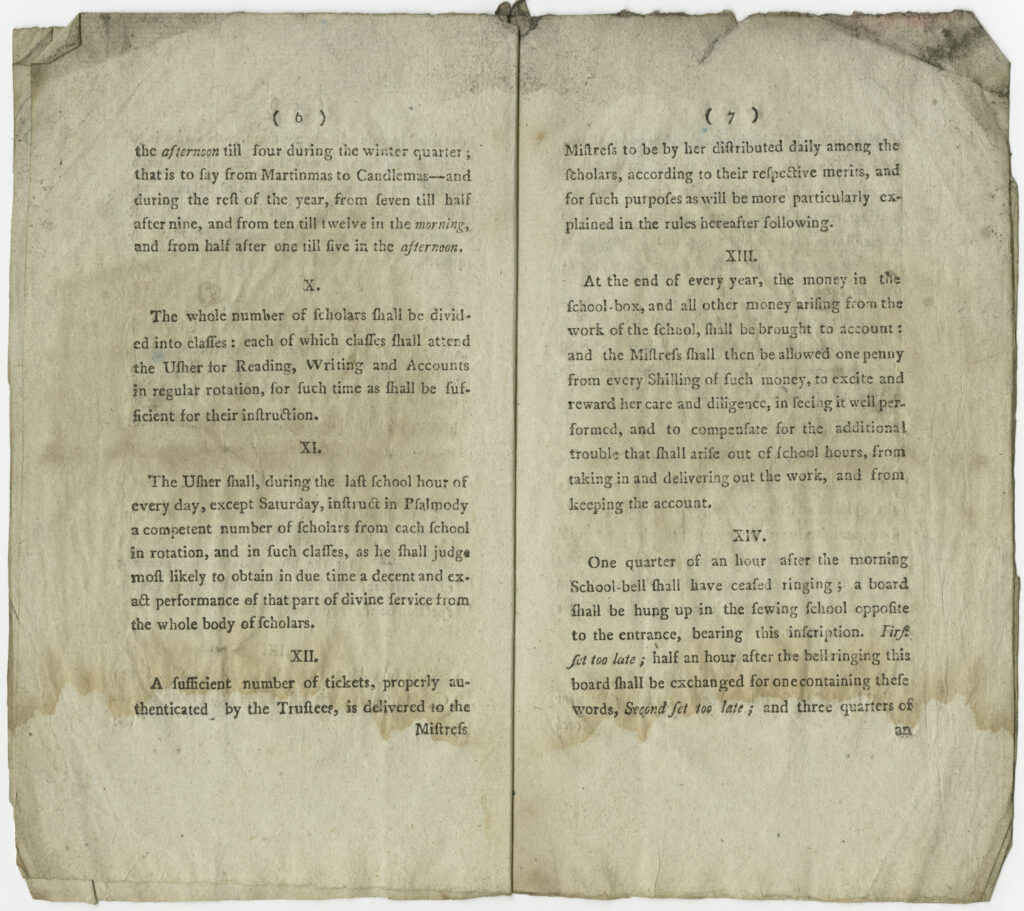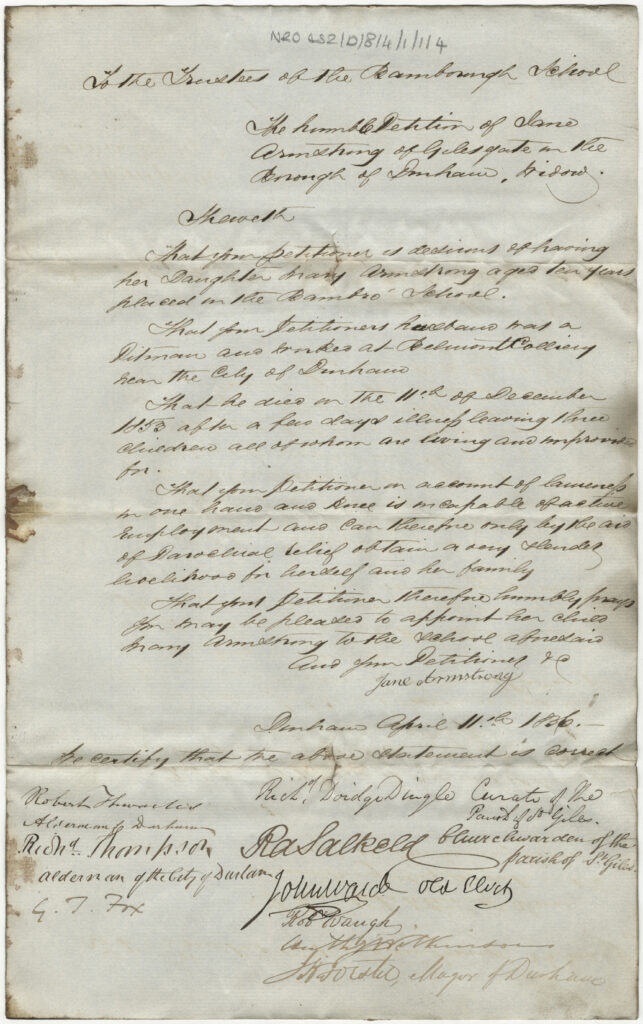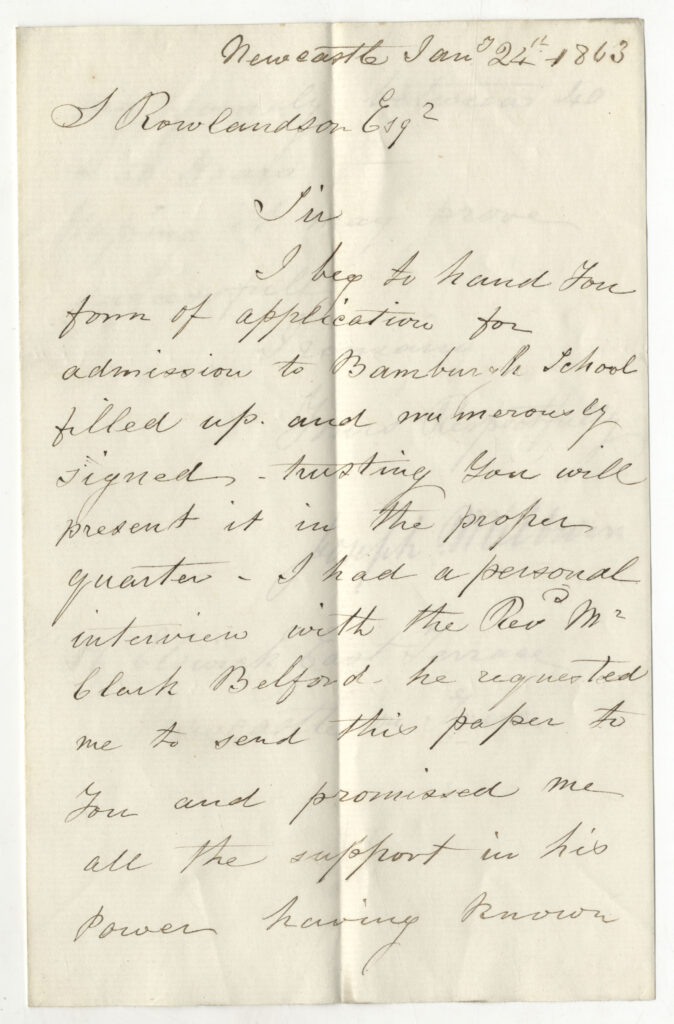SCHOOLS
CONTEXT
The founding of a free, charitable school at Bamburgh Castle for local children was one of the first initiatives established by Dr Sharp. On 26th October 1758 it was agreed and ordered by the trustees that ‘the Old Castle at Bamburgh be turned into a Court Room and which may be on occasion used as a Schoolhouse’. Dr Sharp was stated as ‘desired to give direction in regard thereto as he shall think necessary and proper’. (NRO 00452/J/36 p39).
By September 1762, three rooms in the castle had been fitted for the use of the school at the cost of 44 Guineas. This would have likely been in the Old Roman Tower.
A Schoolmaster was first appointed to teach ‘the poor boys in the Castle’.
On 29th February 1760, the trustees agreed that the previously agreed annual sum of £6 13s 4d, (equivalent to £845.10 in 2023) paid to the Schoolmaster in Bamburgh village, Mr Forster, would now be divided between Mr Forster and the newly appointed Mr Peacock, Schoolmaster at Bamburgh Castle. (NRO 00452/J/36 p46). Dinah Middleton was appointed as Schoolmistress at Bamburgh Castle in May 1760, she received a salary of £5 (equivalent to £808.20 in 2023) per year, paid half-yearly.
By January 1761 it was recorded that Mr Forster had been incapable of upkeeping his duties as Schoolmaster in the village and the full annual sum would be paid to Mr Peacock (NRO 00452/J/36 p49).
In 1762, the trustees ordered that coal, a bed and bedding be made available for the use of the Schoolmaster and Schoolmistress. Dinah Middleton later married Schoolmaster Mr William Smith, with the charity providing provisions for the two to set up their home.
By September 1768, the conditions of pay for the Schoolmaster and Schoolmistress at Bamburgh Castle had changed. The trustees ordered that ‘the sum of two shillings and six pence per quarter till further order, be paid to the Schoolmaster of Bambrough Castle, for each child of every poor person within that parish of Bambrough which he shall teach exceeding the number of twelve over and above his present salary’ and ‘also that two shillings and six pence per quarter till further order, be paid to the Schoolmistress of Bambrough Castle, for each child of every poor person within that parish of Bambrough which she shall teach exceeding the number of ten over and above her present salary’ (NRO 00452/J/36 p77).
A specialist mathematics teacher, John Dial was appointed as second master in 1772, teaching both boys and girls.
Admission to the school was open to children ‘whose parents do not farm to the value of 10 a year or who have not a certain income of ten pounds per annum.’ This is an income equal to £1619.39 in 2023 (Bank of England – inflation calculator).
In a report written in about 1780, it was noted that the charity made provisions for up to 60 boys and 60 girls to be taught, with no more students to be admitted unless granted a special permission by the Trustees, or paid for by their parents. The number of scholars in attendance at any given time was generally around 100.
Boys were taught ‘Latin and English by the Headmaster who is a clergyman, and writing, arithmatick, navigation and other branches of mathematick (if required) by the 2nd maaster.’ Girls were taught ‘Reading, Plainwork, Finework, Knitting etc by a Mistress and writing and Arithmatick by the 2nd Master’ (NRO/452/D/8/4/8/4a). A public lending library was later added during the 1780s.
Any children that are absent for more than six days per quarter were struck off the admissions register for 6 months, except for in cases of sickness or extreme bad weather.
The bell on the south turret of the Old Roman Tower was rung at 6am every morning during the summer and 7am during the winter. It also tolled during school hours and at 8pm all year round.
The school grew to become a boarding school for impoverished girls. By 1877 a larger school was established, providing space for 120 students.
DOCUMENTS
This basic plan of the area within Bamburgh Castle that served as the Girls’ School allows us to begin to imagine a little of what form the school took. We know that both boys and girls were educated in the Castle and that by September 1762 three rooms had been fitted for the use of the school.
By about 1780 the charity had made provisions for up to 60 boys and 60 girls to be taught and that the number of scholars in attendance at any given time was generally around 100. A scale is noted on the plan – this can be used to work out the proportions of the schoolroom.
This document is a printed copy of the rules of Bamburgh Castle School as laid out when the school was established in 1794. The rules provide a fascinating insight into the governance of the school. We learn that it was established to educate sixty poor girls. The girls were to be educated with the intention of placing them in domestic service. This is reflected in the subjects to be taught – knitting, mantua making (dressmaking) and the spinning of wool, linen and jersey. Any income from work produced in the school and sold was to be added to a ‘Common Fund’ and accounts of the Fund were to be kept.
In addition, the girls were to be taught reading, writing and accounts. Time was also spent on religious studies. The school days were long – eight to noon and one to four in winter and seven to ‘after nine’, ten to noon and one-thirty to five during the rest of the year. Church attendance was expected.
A ticket system was to be introduced. Girls were awarded tickets for good behaviour and good work with tickets forfeited for poor attendance and misbehaviour. At the end of each year monies accrued throughout the year were to be distributed to the girls according to the number of tickets accrued.
The front page of the document notes that it was printed by John Catnach of Alnwick, Northumberland. Catnach’s work was of high quality and is held in high regard. He is known to have employed Thomas Bewick to undertake engraving work.
This document forms part of the general series of petitions or applications to the Lord Crewe Charity held by Northumberland Archives. The petition was submitted by Mary Beavens, a widow of Milburngate, Durham City. We learn that Mary Beavens is a widow and mother of three children. Her late husband was Joseph Beavens, a forgeman, of Beamish, County Durham, who died on 1 February 1847. Mary Beavens writes to request that a place be found at Bamburgh Castle School for her daughter, Elizabeth, aged nine. All we learn about the family’s circumstances is that Mary does not have the means to support them. The petition is signed by a number of supporters including John Cundill, incumbent (vicar) of St. Margaret’s parish. It is noted at the top of the document that Mary Beavens lived in the Chapelry of St. Margaret’s, Durham.
This document is one of many hundreds of petitions received by the Trustees of The Lord Crewe Charity requesting support. Over a hundred of these petitions are requests for educational support, generally either for financial support for a particular school or to fund a school place for a named child. This application made by Jane Armstrong for a place for her 10 year old daughter, Mary, at Bamburgh Castle School. We learn from the petition that Jane is a widow, her husband, a pitman at Belmont Colliery, having died on 11 December 1853 after a short illness, leaving his wife with three children to care for. We also learn that Jane Armstrong suffers from ‘lameness in one hand’ and is therefore ‘incapable of active employment’. As a consequence Jane and her family are in receipt of parish relief. The petition is signed by Jane Armstrong and countersigned by nine supporters who certify that the statement of the family’s circumstances is correct. It is interesting to consider who the supporters are – they include two Aldermen of the City of Durham, the curate of St. Giles Church, Durham City and a churchwarden of the same church. The origins of the charity and the terms of its creation meant that it was important for petitioners to demonstrate support from local clergy.
The papers of the Lord Crewe Charity held by Northumberland Archives contain a collection of almost fifty applications for admission to Bamburgh Castle Girls School covering the period 1858-1884. Earlier applications for admission can be found amongst the petition series of the papers. This application was made on behalf of Eliza Louisa Milburn of 56 Elswick East Terrace, Newcastle upon Tyne. The application reveals that her father is Joseph Milburn, an ironmonger, and that her mother is deceased. We also learn that Joseph is almost blind and in ill-health. Eliza was aged 12 at the time of application – her birthdate is noted as 3 May 1850. She was born in Plummer Street, Newcastle upon Tyne, in the parish of Newcastle St. John. The application is signed by a local surgeon and has a number of supporters including John Clayton, Town Clerk of Newcastle, Joseph Armstrong, former mayor of the town, Rev. Moody, the Vicar of Newcastle, Edward Prest, Archdeacon of Durham as well as clergy and lay persons of St. Anne’s church – possibly the chapelry of Newcastle, St Ann. The origins of the charity and the terms of its creation meant that it was important for petitioners to demonstrate support from local clergy.
The application was accompanied by a letter signed by Joseph Milburn dated 24 January 1863. In it, Joseph Milburn states that he has had a personal interview with Rev. Clark of Belford who has advised that Joseph to send the application to Samuel Rowlandson, one of the Trustees. Joseph Milburn also writes that Rev. Clark has known the Milburn family for between 40 and 50 years.
The papers of the Lord Crewe Charity held by Northumberland Archives include a register of girls recommended for admission to Bamburgh Castle School, 1879-1892.This sample page from 1882 provides details of five girls recommended for admission. Details recorded are date of application, name and age of girl, details of family circumstances, names of persons recommending the application, name of person who will provide clothing and outcome of application. In four of five cases cited the family have lost one parent. The case of Margaret Wilson aged nine and a half is typical. Margaret’s mother is the widow of a commercial traveller who died in July 1882. Margaret is one of six children, four of whom are described as being ‘very dependant’ upon their mother. Mrs. Wilson has a life policy of £100 but no other [financial] support. She relies upon ‘her needle’ (sewing) for other income.
From 1862 schools were required to keep a logbook. Headteachers were expected to make daily entries recording the business of the school. From 1871 weekly entries could be made. This sample page is from a volume covering the period 1881-1893. Entries are recorded for most schooldays. There are several references to named pupils – for example, two members of the Handyside family were admitted to school on 20 November 1888. We learn that regular church attendance was important and that the vicar, Rev. Long, was a regular visitor to the school. On 7 December 1888 school was dismissed early at 3.30pm – it is possible to speculate that this may have been because of poor weather. We see reference to homework being allocated on 9 December 1888. The sample page gives a clear indication of the wealth of information that school logbooks can provide.
The Charities of Nathaniel, Lord Crewe and Dr John Sharp 1721-1976 by CJ Stranks published by the Dean and Chapter of Durham 1976.
Memoirs of Nathaniel, Lord Crewe edited by Rev. Andrew Clark printed for the Camden Society 1893.
The Good Sharps by Hester Grant, Penguin Random House 2020
Dilston Hall…A Visit ot Bamburgh Castle with an account of Lord Crewe’s charties etc by WS Gibson published by Longman, Brown, Green and Longmans 1850
Dorothy and the Forsters of Bamburgh by John Bird, published by John Bird 1982
Bamburgh Belford Warenmouth Spindleston Outchester by Frank Graham published by Frank Graham 1976
Lord Crewe’s Charity website: https://www.lordcrewescharity.org.uk/
Northumberland Archives exhibition on Lord Crewe’s Charity: https://northumberlandarchives.com/exhibitions/crewe/1.html
Bamburgh Research Project website: https://bamburghresearchproject.wordpress.com/
Northumberland Archives blog on the electrifying machine: https://northumberlandarchives.com/test/2020/05/05/the-electrifying-machine-bamburgh-castle/
BBC Free Thinking feature on Bamburgh Castle surgery: https://dralun.wordpress.com/2015/11/02/bbc-free-thinking-feature-bamburgh-castle-surgery-c-1770-1800/
Article on overcrowded and underfunded 18th century hospitals: https://dralun.wordpress.com/2014/10/06/overcrowded-and-underfunded-18th-century-hospitals-and-the-nhs-crisis/
Article on 18th century medical jobs at Bamburgh Castle: https://dralun.wordpress.com/2014/01/22/do-you-need-a-doctor-applying-for-medical-jobs-in-the-eighteenth-century/
Article on 18th century medical job wages at Bamburgh Castle: https://dralun.wordpress.com/2014/01/24/negotiating-a-pay-rise-18th-century-style/
History Today article on Bamburgh Castle infirmary and dispensary: https://www.historytoday.com/hidden-hospital-bamburgh-castle-infirmary-and-dispensary
Article on Dr John Sharp: https://www.philanthropynortheast.com/the-philanthropists/sharp-dr-john
Bamburgh Bones website: https://bamburghbones.org/














